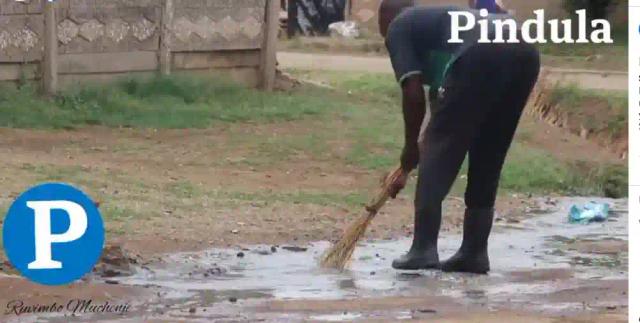Harare Gives Update On Growing Number Of Cholera Cases And Ongoing Water Problems

The Harare City Council (HCC) has provided an update on the growing number of cholera cases in the city and the ongoing water problems. According to the local government authority’s statement seen by Pindula News, the cases of cholera in Harare are increasing. As of 23rd November 2023, there have been 150 confirmed cases and 15 deaths in Harare. The statement read in part:
The most affected areas are Kuwadzana, Glen View, Glen Norah and Budiriro. The following have been identified as factors contributing to the spread of cholera:
1. Drinking of untreated borehole water
Feedback2. Drinking untreated well water
3. Attending and eating at gatherings
HOT DEALS:
itel A70 - (128GB, 3GB RAM) $89,
itel A70 - (256GB, 4GB RAM) $99
itel P40 (128GB, 4GB), (6000mAh) $99
itel P40 (64GB, 4G), (6000mAh) $93
Cash on Delivery in Harare & Bulawayo. Tinotumira kwamuri inosvika.WhatsApp: 0783 450 793
4. Attending gatherings and shaking hands
5. Presence of burst sewers in the communities
6. Consumption of cooked food from unlicensed vendors
The Harare City Council has suggested some recommendations to address the cholera outbreak. They are urging everyone to work together to prevent more people from getting infected and dying from cholera. They are also asking people to report any suspected cases of cholera. It is important for everyone to cooperate and take action to stop the spread of the disease. We present the recommendations below:
a. seek early treatment to prevent death. Treatment is free at all council clinics.
b. Avoid gatherings.
c. Treat all borehole and well water with water guard or aquatabs before drinking
d. Avoid food from unlicensed vendors
e. Report any suspected cholera case or death at the nearest clinic.
Some individuals who read the statement expressed their disappointment, stating that they feel the local government authority is not taking the disease seriously.
The local government authority acknowledges that water is a major factor contributing to the cholera outbreak. However, they have been unable to effectively address the long-standing water problems faced by the city. In a recent update on the water situation, the city authorities admitted that certain areas in the city have been without access to water. Read the update:
There was a serious burst on our internal reticulation network at Prince Edward yesterday (Wednesday) at 2200hrs. As a result of this, the plant was shut down as chemicals could not be prepared.
This shutdown has negatively affected water supply to the southern suburbs.
Work to repair the pipe is ongoing and normal operations are expected to resume anytime soon.
The affected areas include R.G. Mugabe International Airport, Cranborne, and Hatfield, parts of Chitungwiza, Mbare, Sunningdale and Graniteside.
Most areas in the southwestern suburbs including Glen Norah, Glen View, Kuwadzana and Rydle Ridge are accessing water except for Budiriro which is currently not accessing water.
The north-western suburbs including Tynwald, Bloomingdale and Dzivaresekwa are not accessing water.
Water supply to the northern suburbs including Hatcliffe, Borrowdale, Mt. Pleasant, Hogerty Hill and Helensvale is yet to be restored.
Other areas in the zone like Vainona, Gunhill and New Alex are now accessing water.The CBD and surrounding are accessing water.
The eastern suburbs of Greendale, Mandara, Mabvuku, Tafara, Zimre Park and Epworth are currently not accessing water.
On the 23rd of November 2023, Harare was only able to supply 411 megaliters of water, even though the daily demand is over 1,200 megaliters per day. The water infrastructure in Harare was originally built in 1953 to support a population of 300,000. However, the city now has around 7 million people during the day and approximately 2 million at night.
Harare’s Deputy Mayor, Kudzai Kadzombe, recently stated that the city is unable to provide the required 1.2 million megaliters of water to ensure that every household has access to running water. She mentioned that the only solution is to look for other sources of water, such as the Kunzvi Dam. She told She Corresponds Africa:
The Government of Zimbabwe is the one which is supposed to provide new sources of water such as Kunzvi Dam under the President’s office not through Harare City Council.
In addition to the water shortage problem, it has been discovered through tests that the water provided to people’s homes by the local authority in Harare does not meet the standards set by the World Health Organization (WHO). Furthermore, when the water comes out of the tap, it appears greenish in colour. Tests have shown that the water from boreholes in many neighbourhoods, both low-density and high-density areas, is contaminated. Water from unprotected sources such as shallow wells is also unsafe to drink. This contamination is believed to be the cause of the recurring cholera cases in the city. Due to these issues, many people in Harare are relying on private boreholes and wells in their homes to ensure they have access to safe and clean water for sanitation purposes.
More Pindula News
Tags
6 Comments
Leave a Comment
Generate a Whatsapp MessageBuy Phones on Credit.
More Deals





